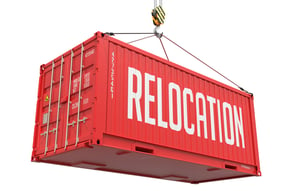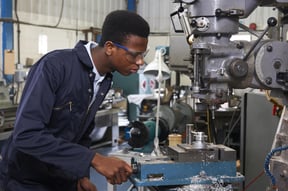July 7, 2015 | Business Growth Strategy & Strategic Planning
Moving to a New Facility? Here's A Checklist of Items to Consider
For manufacturers, changing facility locations can be a long, expensive, and frustrating process. When moving your production facility from one location to another, you naturally want to avoid unnecessary complications that could pile on more expenses or create delays in getting your new lean manufacturing facility up and operational.
Avoiding complications and ensuring a steady move requires manufacturers to use a clear, consistent process that is well-documented, just like your lean manufacturing practices.
With this in mind, we have assembled a brief planning guide for completing a change of facility locations to help you establish a reliable process that will minimize lost production time and expenses related to the move.
Step 1: Review Your Decision to Relocate
 After you’ve made the choice to move your production facility to a new location, take some time to review your decision in detail.
After you’ve made the choice to move your production facility to a new location, take some time to review your decision in detail.
Go over the risks, resource demands, legal issues, and other changes/requirements that the move to a new facility will entail. Including senior management or staff that are key to your operations in this review, can help you form a more complete picture of what the move will require.
Also, be sure to double- and triple-check the new location to make sure that it has adequate resources such as power, gas, water, internet access, roadway access, etc. Otherwise, you could end up moving your company to a new location that may not serve your needs as well as the previous location.
Step 2: Communicate the Intent to Move
Your company’s relocation to a new facility should not come as a surprise to workers, clients, investors, and authorities.
Create a press release and internal memos regarding your company’s intention to move well before the actual date of the relocation. Include the new location’s address and the expected date of completion for the move in your communications.
Establish whether or not you’ll be moving the majority of your employees with your company to the new facility, and create plans and incentives to keep your top talents with you after the move. The farther away the new location is from the old one, the more difficult this task will be, especially for your employees who have spouses with jobs of their own.
For communications with customers, clearly establish how the move is going to affect production timetables.
Step 3: Create a Layout for the New Facility
Having a plan in mind for the placement of your company’s equipment and workstations at the new facility well before you ever arrive there is key to a smooth transition.
During this planning phase, keep in mind lean manufacturing principles, such as minimizing the time parts/products spend in transition from one workstation to the next. This is an excellent opportunity to rearrange the placement of your company’s equipment.
Step 4: Prepare Your Company’s QMS Documents and Records for Transfer
Make sure to take all of your company’s quality management system (QMS) documents from your distribution list and prepare to reissue them at your new facility location. The distribution list for your company should be updated to reflect the changes in your distribution plan caused by the move to the new facility.
Furthermore, you need to create a plan for moving all of your company’s other records and onsite data storage to the new facility in a secure manner. This plan should minimize your risk of losing important documents in transit from point A to point B.
Having secure data backups of your company’s records can be helpful in case of a disaster during transit.
Step 5: Consider Your Identification and Traceability Requirements
Establish a plan for ensuring that all of your company’s identification and traceability requirements will be maintained before, during, and after the move. This, of course, includes and work you have in progress at the time of the move.
Any customer property that you have in your possession should be thoroughly inventoried and tracked during the moving process so that the risk of customer materials, parts, tooling, etc. that could be lost is minimized. This includes a condition check of the customer property before and after the move to verify that no damage was done during the move.
Your own company’s property should be inspected and tracked in a similar fashion.
Step 6: Preserve Products during Transit
When moving facility locations, your company should do everything it can to preserve the current condition of any products being moved. This includes any and all products with a shelf life.
In fact, products with a shelf life should be stored in a manner that ensures that the first product in is the first product out.
Step 7: Handle Calibrated Equipment with Special Care
If you have equipment that needs to be calibrated, that equipment needs to be packed and transported in a way that keeps that equipment within its operational tolerance.
When calibrated equipment arrives at the new facility, it should be given a thorough inspection before use. It is also a good idea to recalibrate the equipment before its first use, just to be sure.
Step 8: Test Your Equipment after the Move

Every production machine that you move from the old facility to the new one should have a test piece made on it. This way, you can verify that the machines are in good working order after the move before putting a piece of equipment with a problem into full production mode.
If your company is an aerospace manufacturer, then a First Article Inspection Report (FAIR) should also be completed on the first production run of any part.
Step 9: Perform an Internal Audit
Now that your new facility is up and running, you should run an internal audit to make sure that your production process is running smoothly. You may find new opportunities for making your production process even leaner than it was before.
Step 10: More Communication
Upon completing your move and making sure your new facility is fully operational, it’s time to send out another communication to your customers and the regulatory bodies your company has to report to.
Aerospace companies should also update their OASIS accounts to reflect their new facility locations.
Step 11: Final Review
Conduct one last review of your company’s move to discuss the moving process and the results of your internal audit.
Hopefully, this guide will help you to simplify your company’s move from one facility location to the next, as well as avoid the complications and hassles that often go with a production facility relocation.
Our thanks to Jay Wiessner, Quality Systems Consultant, for his contribution to this blog post.
To learn more about how to establish and maintain lean manufacturing principles, check out additional manufacturing topics here.

